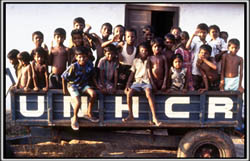 The UNHCR 
The UNHCR headquarters is in Geneva. From here it operates a worldwide relief agency via 244 offices in 118 countries, setting up and monitoring international refugee agreements and working closely with governments and NGO's to implement its humanitarian charter. It organises operations and sends field workers to support refugees in different countries, often in very dangerous and difficult conditions. The UNHCR aims to:
Women and children make up more than 80% of most refugee populations, and they are frequently victims of physical abuse. The UNHCR works with other relief agencies to reunite unaccompanied children with their families as quickly as possible. They are now working and consulting more closely with refugee women when planning help and skills training. Originally, the UNHCR was concerned only with refugees who had crossed international boundaries. Today it also deals with the increasing problem of internally displaced people (IDPs). The humanitarian needs of such people are often critical, even though they may not have official refugee status. The UNHCR finances and supports resettlement programmes all over the world. In Mozambique in the early 1990s, following years of civil war, $100 million was spent on providing seeds, tools and other equipment as well as financing the rebuilding of roads, bridges and schools as almost 1.7 million people returned home once the fighting had stopped.
In major emergencies, the UNHCR organises and co-ordinates international humanitarian response. It works to provide shelter, food, water, sanitation, education and medical care and has frequently been called upon to provide relief in huge quantities and at very short notice. The blue plastic sheeting supplied by UNHCR for makeshift tents has become a familiar sight in refugee crisis situations. The UNHCR has twice been awarded the Nobel Peace Prize for its work. Although there is a very long history of offering asylum to the persecuted, the 20th century has seen a massive increase in the numbers of refugees and displaced people, chiefly as a result of war and persecution. The UNHCR frequently co-ordinates the world's response to the challenge of caring for them. Sadly it seems to be a challenge which is set to continue well into the next century. UNHCR Website |
